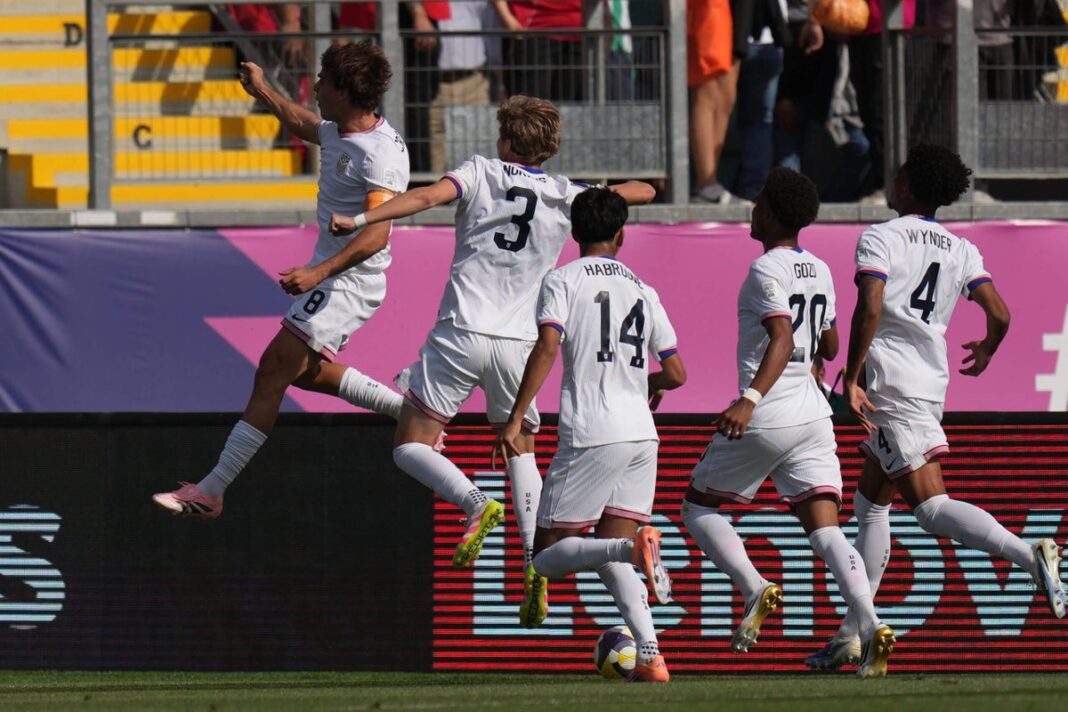The United States has made its mark in the youth soccer world, advancing to the quarterfinal round of the U-20 men’s World Cup for the fifth consecutive competition. This achievement was cemented with a decisive 3-0 victory over Italy on Thursday. The Americans showcased their dominance in the match, with Benjamin Cremaschi scoring twice, complemented by a stunning free kick from Niko Tsakiris, all while dominating their opponents throughout the game. The Azzurri, struggling to find form, presented little challenge, despite having two late penalty appeals reviewed by VAR that went unheeded.
Cremaschi’s impressive double performance pushed him to the top of the tournament’s scoring charts, bringing his total to five goals. The first of his goals came in the 15th minute, as he capitalized on a scramble in front of the goal, poking the ball home from close range after a well-executed corner kick. His second goal was a thing of beauty, occurring in stoppage time when he delicately lobbed the ball over the Italian goalkeeper after receiving a cross while sprinting through the center. This performance not only highlights his skill but also mirrors his earlier feat of scoring a hat trick in the tournament, making him only the second American to achieve this distinction, following Freddy Adu in 2007.
Tsakiris contributed equally to the scoreline, curling a magnificent free kick from just outside the penalty area into the net in the 79th minute, extending the U.S. lead to 2-0. Marko Mitrović’s squad has benefitted from the favorable location of Estadio El Teniente in Rancagua, where they have performed consistently well. Their upcoming quarterfinal match against either Morocco or South Korea promises to bring further challenges as they aspire to reach the semifinals for the first time since 1989.
This U-20 World Cup reflects a blend of nostalgia and excitement, taking place in Chile, a country rich in soccer history. The charm of the older concrete stadiums in cities such as Santiago, Talca, and Viña del Mar evokes memories of previous World Cups and adds a distinct atmosphere to this year’s tournament. Indeed, the aesthetics here contrast sharply with the glitzy senior World Cups, grounding fans in a raw and authentic experience reminiscent of vintage competitions. Interestingly, the last U-20 World Cup held in Chile in 1987 saw Yugoslavia’s Robert Prosinecki shine, foreshadowing a future star of the 1990s.
Brazil’s unexpected exit from the knockout stage has been another shocking storyline. For the first time in history, the Brazilian U-20 team finished at the bottom of their group with just a single point, resulting in the dismissal of their head coach, Ramon Menezes. This surprising turn of events highlights the unpredictable nature of tournament soccer and suggests significant shifts in youth football dynamics.
On the home front, Chile’s U-20 team suffered a disappointing exit too, losing 4-1 to Mexico in the Round of 16, which drew heavy criticism from fans. Meanwhile, Mexico’s U-20 side has become one of the touted teams of the tournament, showcasing young talent, particularly in midfielder Gilberto Mora, who remains a highly-sought player. Mora, only 16 years old, played a pivotal role in Mexico’s victory at the Gold Cup earlier this year and is already drawing interest from major European clubs, indicating his potential as a future superstar.
While the U.S. squad may not feature a standout global phenomenon like Mora, they are brimming with technical skill and potential. Standout performances from Cremaschi and defensive midfielder Brooklyn Raines have been instrumental in driving the team forward in this competition. The current generation of U.S. players may not yet boast the storied legacies of previous U-20 stars such as Michael Bradley, DaMarcus Beasley, and Landon Donovan. Still, they embody a quiet confidence, suggesting a team that may be peaking at the right moment for a memorable tournament run.



